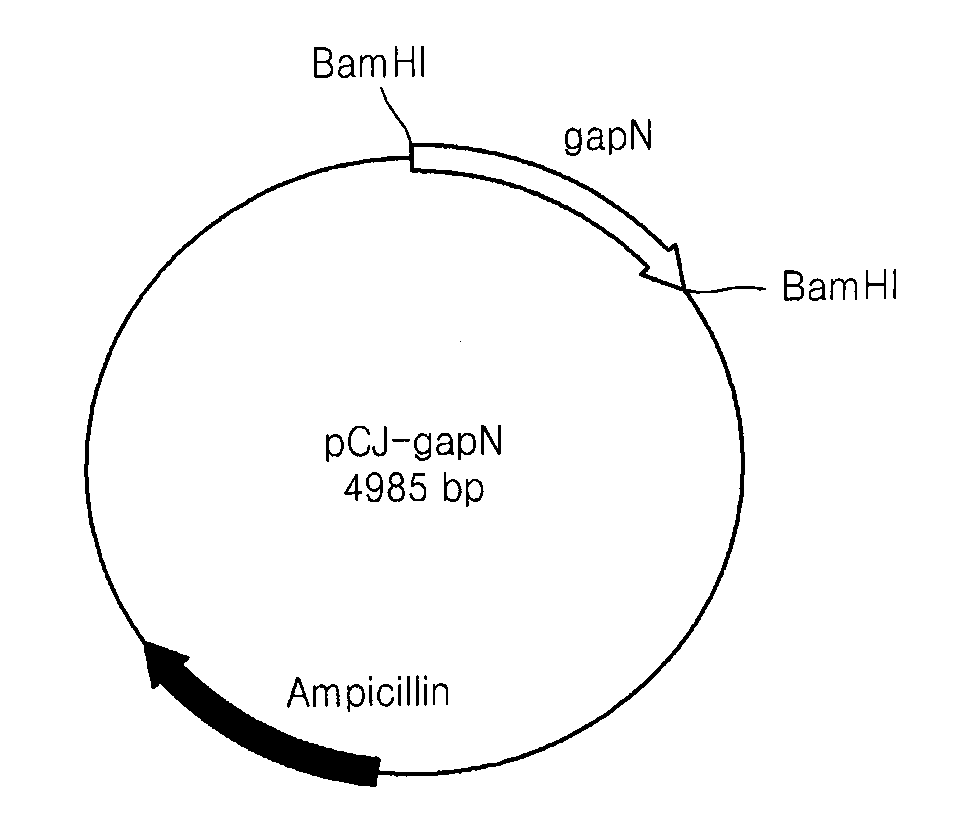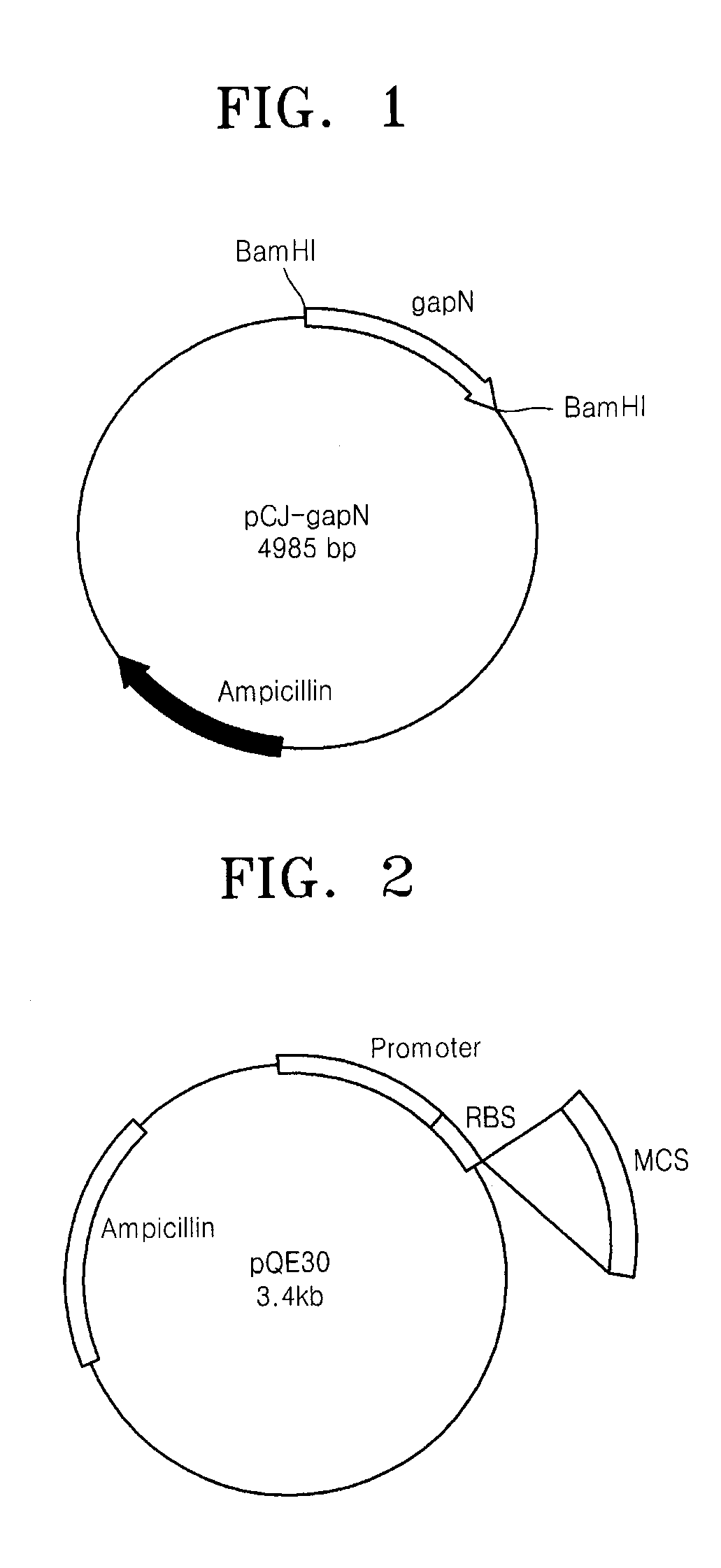Microorganism of Escherichia Sp, or Corynebacterium Sp, Comprising Foreign Nadp Dependent Glyceraldehyde-3-Phospate Dehydrogenase Gene and Method For Prodicing L-Lysine Using the Same
a technology of escherichia sp and corynebacterium sp, which is applied in the field of escherichia sp microorganisms or corynebacterium species microorganisms, can solve problems such as the example of developing a strain with improved l-lysine productivity
- Summary
- Abstract
- Description
- Claims
- Application Information
AI Technical Summary
Benefits of technology
Problems solved by technology
Method used
Image
Examples
example 1
Preparation of Lysine-Producing E. coli Strain K225 and Confirmation of its Characteristics
[0026]An Escherichia coli strain TF1 (Korean laid-open Patent No. 1992-0012444) was grown until the strain entered an exponential growth phase and suspended in a 0.1 M phosphate buffer (pH 7.0) or 0.1 M citrate buffer solution (pH 5.5). N-methyl-N′-nitro-nitrosoguanidine was added into the suspension to a final concentration of 200-500 μg / mL, reacted at 30° C. for 10-30 minutes, and inoculated into a minimum agar plate containing 1-30 g / L of a lysine analogue (AEC: S-(2-aminoethyl)-L-cysteine) to select an analogue-resistant strain. This strain was named “CJ40225”. The resistance of the strain against the lysine analogue was tested using an M9 minimum medium, and the relative growth rate was measured. The results are shown in Table 1.
TABLE 1Relative Growth Rates of Wild type E. coli strain, TF1, and CJ40225with respect to the concentration of AECRelative Growth Rate (%)*Concentration of added ...
example 2
Screening and Cloning of NADP Dependent glyceraldehyde-3-phosphate dehydrogenase Gene (gapN) Derived from Clostridium
[0031]The sequence of a NADP dependent glyceraldehyde-3-phosphate dehydrogenase (gapN) gene derived from Clostridium had been identified. Information on an NADP dependent glyceraldehyde-3-phosphate dehydrogenase gene (gapN) of Clostridium acetobutylicum with Accession No. NP—350239 was obtained from the NIH GenBank. PCR was performed using oligonucleotides of SEQ ID Nos. 1 and 2 as primers and a chromosomal DNA of a Clostridium acetobutylicum ATCC 824 strain as a template based on the gene sequence information to amplify the NADP dependent glyceraldehyde-3-phosphate dehydrogenase gene (gapN) to 1485 bp. During the PCR, a cycle of denaturation 94° C. for 30 seconds, annealing at 51° C. for 30 seconds, and polymerization at 72° C. for 1 minute was repeated 25 times. The resulting PCR products were cloned with E. coli plasmid pCR2.1 using a TOPO Cloning Kit (Invitrogen ...
example 3
Construction of NADP Dependent glyceraldehyde-3-phosphate dehydrogenase Gene Expression Vector
[0032]The vector pCR-gapN containing the NADP dependent glyceraldehyde-3-phosphate dehydrogenase gene obtained in Example 2 was cleaved with a restriction enzyme BamHI to separate only a gene fragment encoding NADP dependent glyceraldehyde-3-phosphate dehydrogenase. The gene fragment was ligated to an E. coli expression vector pQE30 (Qiagen Corp.) using a ligation enzyme to enable the gene to be expressed in cells by a T5 promoter of bacteriophage existing in the vector. FIG. 2 is a map of the vector PQE30. Next, an E. coli DH5α strain was transformed through heat shocking and cultured in a Lurina-Bertani (LB) agar medium containing 100 μg / mL of ampicillin to screen transformed strains. The expression vector pCJ-gapN was separated from each of the transformed strains.
PUM
| Property | Measurement | Unit |
|---|---|---|
| Fraction | aaaaa | aaaaa |
| Fraction | aaaaa | aaaaa |
| Fraction | aaaaa | aaaaa |
Abstract
Description
Claims
Application Information
 Login to View More
Login to View More - R&D
- Intellectual Property
- Life Sciences
- Materials
- Tech Scout
- Unparalleled Data Quality
- Higher Quality Content
- 60% Fewer Hallucinations
Browse by: Latest US Patents, China's latest patents, Technical Efficacy Thesaurus, Application Domain, Technology Topic, Popular Technical Reports.
© 2025 PatSnap. All rights reserved.Legal|Privacy policy|Modern Slavery Act Transparency Statement|Sitemap|About US| Contact US: help@patsnap.com


